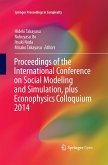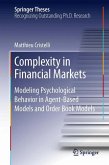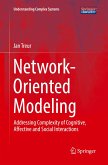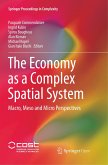Econophysics and Sociophysics: Recent Progress and Future Directions
Herausgegeben:Abergel, Frédéric; Aoyama, Hideaki; Chakrabarti, Bikas K; Chakraborti, Anirban; Deo, Nivedita; Raina, Dhruv; Vodenska, Irena
Econophysics and Sociophysics: Recent Progress and Future Directions
Herausgegeben:Abergel, Frédéric; Aoyama, Hideaki; Chakrabarti, Bikas K; Chakraborti, Anirban; Deo, Nivedita; Raina, Dhruv; Vodenska, Irena
- Broschiertes Buch
- Merkliste
- Auf die Merkliste
- Bewerten Bewerten
- Teilen
- Produkt teilen
- Produkterinnerung
- Produkterinnerung
This book presents the proceedings from ECONOPHYS-2015,an international workshop held in New Delhi, India, on the interrelated fieldsof "econophysics" and "sociophysics", which have emerged from the applicationof statistical physics to economics and sociology. Leading researchers fromvaried communities, including economists, sociologists, financial analysts,mathematicians, physicists, statisticians, and others, report on their recentwork, discuss topical issues, and review the relevant contemporary literature.
A society can be described as a group of peoplewho inhabit the same geographical…mehr
Andere Kunden interessierten sich auch für
![Econophysics of Agent-Based Models Econophysics of Agent-Based Models]() Econophysics of Agent-Based Models112,99 €
Econophysics of Agent-Based Models112,99 €![Proceedings of the International Conference on Social Modeling and Simulation, plus Econophysics Colloquium 2014 Proceedings of the International Conference on Social Modeling and Simulation, plus Econophysics Colloquium 2014]() Proceedings of the International Conference on Social Modeling and Simulation, plus Econophysics Colloquium 201438,99 €
Proceedings of the International Conference on Social Modeling and Simulation, plus Econophysics Colloquium 201438,99 €![Complexity in Financial Markets Complexity in Financial Markets]() Matthieu CristelliComplexity in Financial Markets75,99 €
Matthieu CristelliComplexity in Financial Markets75,99 €![Network-Oriented Modeling Network-Oriented Modeling]() Jan TreurNetwork-Oriented Modeling75,99 €
Jan TreurNetwork-Oriented Modeling75,99 €![New Perspectives and Challenges in Econophysics and Sociophysics New Perspectives and Challenges in Econophysics and Sociophysics]() New Perspectives and Challenges in Econophysics and Sociophysics97,99 €
New Perspectives and Challenges in Econophysics and Sociophysics97,99 €![Banking Beyond Banks and Money Banking Beyond Banks and Money]() Banking Beyond Banks and Money112,99 €
Banking Beyond Banks and Money112,99 €![The Economy as a Complex Spatial System The Economy as a Complex Spatial System]() The Economy as a Complex Spatial System38,99 €
The Economy as a Complex Spatial System38,99 €-
-
-
This book presents the proceedings from ECONOPHYS-2015,an international workshop held in New Delhi, India, on the interrelated fieldsof "econophysics" and "sociophysics", which have emerged from the applicationof statistical physics to economics and sociology. Leading researchers fromvaried communities, including economists, sociologists, financial analysts,mathematicians, physicists, statisticians, and others, report on their recentwork, discuss topical issues, and review the relevant contemporary literature.
A society can be described as a group of peoplewho inhabit the same geographical or social territory and are mutually involvedthrough their shared participation in different aspects of life. It is possibleto observe and characterize average behaviors of members of a society, an examplebeing voting behavior. Moreover, the dynamic nature of interaction within anyeconomic sector comprising numerous cooperatively interacting agents has manyfeatures in common with theinteracting systems of statistical physics. It ison these bases that interest has grown in the application within sociology andeconomics of the tools of statistical mechanics. This book will be of value forall with an interest in this flourishing field.
A society can be described as a group of peoplewho inhabit the same geographical or social territory and are mutually involvedthrough their shared participation in different aspects of life. It is possibleto observe and characterize average behaviors of members of a society, an examplebeing voting behavior. Moreover, the dynamic nature of interaction within anyeconomic sector comprising numerous cooperatively interacting agents has manyfeatures in common with theinteracting systems of statistical physics. It ison these bases that interest has grown in the application within sociology andeconomics of the tools of statistical mechanics. This book will be of value forall with an interest in this flourishing field.
Produktdetails
- Produktdetails
- New Economic Windows
- Verlag: Springer / Springer International Publishing / Springer, Berlin
- Artikelnr. des Verlages: 978-3-319-83802-1
- Softcover reprint of the original 1st ed. 2017
- Seitenzahl: 264
- Erscheinungstermin: 7. Juli 2018
- Englisch
- Abmessung: 235mm x 155mm x 15mm
- Gewicht: 409g
- ISBN-13: 9783319838021
- ISBN-10: 3319838024
- Artikelnr.: 53569937
- Herstellerkennzeichnung Die Herstellerinformationen sind derzeit nicht verfügbar.
- New Economic Windows
- Verlag: Springer / Springer International Publishing / Springer, Berlin
- Artikelnr. des Verlages: 978-3-319-83802-1
- Softcover reprint of the original 1st ed. 2017
- Seitenzahl: 264
- Erscheinungstermin: 7. Juli 2018
- Englisch
- Abmessung: 235mm x 155mm x 15mm
- Gewicht: 409g
- ISBN-13: 9783319838021
- ISBN-10: 3319838024
- Artikelnr.: 53569937
- Herstellerkennzeichnung Die Herstellerinformationen sind derzeit nicht verfügbar.
Frédéric Abergel is a Professor and Director of the Laboratory of Mathematics Applied to Systems, École Centrale Paris, Grande voie des vignes, Châtenay-Malabry, France. His research interests include financial markets, modeling of derivatives, and empirical properties of financial data. He has organized a number of international conferences and is also managing editor of the journal Quantitative Finance . He has published many articles in peer-reviewed journals. Anirban Chakraborti is a Professor at Jawaharlal Nehru University, India. He gained his PhD in Physics in 2003 for a thesis entitled "Application of Statistical Physics to some Econophysics and Optimization Problems" and in 2009 he was awarded an Indian National Science Academy Young Scientist Medal. His current research focuses on statistical physics and its interdisciplinary application to problems in complex systems in economic and social sciences, and combinatorial optimization. Hideaki Aoyama is a Professor in the Department of Physics, Graduate School of Science, Kyoto University, Japan. Prior to taking up this position in 2003, he was Professor in the Faculty of Integrated Human Studies and College of Liberal Arts and Sciences. He has published 46 research papers in physics, 3 in linguistics, and 25 in econophysics. He is a lifetime member of the American Physical Society and former president of the Kyoto chapter of the Japanese Physical Society. Bikas K. Chakrabarti is Senior Professor of Physics at the Saha Institute of Nuclear Physics, Kolkata, India and Visiting Professor of Economics at the Indian Statistical Institute, Kolkata. He was elected as a Fellow of the Indian Academy of Sciences in 1997 and a Fellow of the Indian National Science Academy in 2003. His interests are condensed matter physics, statistical physics, and computational physics and he is the author of more than 150 refereed papers. Nivedita Deo is Associate Professor in the Department of Physics and Astrophysics, University of Delhi, India. Her research interests include statistical mechanics of superstrings, quantum chaos, glasses, the spectrum of instantaneous normal modes in liquids and random matrices, and the mathematical properties of random matrix models. She is the author of many articles in peer-reviewed publications. Dhruv Raina is a Professor at the Zakir Husain Centre for Educational Studies, School of Social Sciences, Jawaharlal Nehru University, New Delhi, India. He is also Honorary Director of the Northern Regional Centre, Indian Council for Social Science Research. Professor Raina has received many honors and awards. He has held the Heinrich Zimmer Chair for Indian Philosophy and Intellectual History at the University of Heidelberg, Germany and in 2015 was Visiting Professor at Université Paris Diderot. Irena Vodenska is Assistant Professor in the Administrative Sciences Department, Metropolitan College, Boston University, USA. In addition to teaching finance courses, she has directed interdisciplinary research in collaboration with Boston University College of Arts and Sciences Physics Department. She is also Chief Investment Officer and founding partner of Amectron International LLC, Boston, Mass. and past Associate Director for Research, Center for Finance, Law, and Policy, Boston University.
Anindya S.Chakrabarti, Topology of the international trade network: size, asymmetry andvolatility.- Attilio Stella, Optimal growth in the network of global economy.- BikasK. Chakrabarti, Inequality in Societies, Academic Institutions & ScienceJournals: Gini & k-indices.- Damien Challet, Market nanostructure insightinto market stylized facts.- Deepak Dhar, Dynamical networks of agents withdegree preference.- Diego Garlaschelli, Network reconstruction, systemic risk,and early-warning signals.- Dipankar Gupta, Boundaries, Transgressions andDisciplinary Dynamics.- Emanuele Pugliese, New Metrics for Economic Complexity.-Fabrizio Lillo, Complex network methods for systemic risk assessment.- FrédéricAbergel, Imperfections of financial markets: a limit order book perspective.- HarbirLamba, Modelling momentum traders in a financial market usingPrandtl-Ishlinskii operators.- Hideaki Aoyama, Deflation and Money.- IrenaVodenska, Bi-partite network approach to predictabilityof financial marketsand news sentiments.- János Kertész, Kinetics of Social Contagion.- JoshinMurai, A model of order signs under multiple order splitting and publicinformation.- Karmeshu, Stochastic Modelling of High Frequency Intra-day StockReturns: Emergence of Cubic Power-Law.- Kimmo Kaski, Social Physics: Studies ofin vivo / in situ human sociality.- Kousik Guhathakurta, Comparing thecomplexity of emerging and developed stock markets using recurrence networkanalysis.- M.S. Santhanam, Records statistics and financial time series.- MarcoPatriarca, The microscopic origin of the Pareto law and other power-lawdistributions.- Matteo Marsili, Complexity driven collapse of economicequilibria.- Michele Caraglio, Bridging intraday and interday market behaviorthrough scaling.- Parongama Sen, Segregation dynamics with continuously varyingutility factor.- Sandeep Juneja, Nearest neighbor based and other popularmethods for pricing Bermudan options.- Sitabhra Sinha, Loss of structuralbalance in the network of cross-correlations characterizing a financial marketsignals the onset of major economic crisis.- Stanislao Gualdi, A dynamic modelof input-output production networks: general equilibrium stability andemergence of scale-free structures.- Taisei Kaizoji, Why does the power law forshare price hold?.- Takaaki Ohnishi, Real estate valuation using k-nearestneighbor regression.- Takayuki Mizuno, Statistically detecting stock bubblesbefore they burst.- Victor Yakovenko, Economic inequality from statisticalphysics point of view.- Yoshi Fujiwara, Quantifying Financial Distress in aNation-wide Production Network.- Yoshiyuki Arata, Macroeconomic Consequences ofLumpy Investment under Uncertainty.- Youngna Choi, Tracking FinancialInstability Contagion: modeling and data calibration.- Yuichi Ikeda, Communityand Controllability of Global Production Network: Focusing on the EconomicCrisis of 2008.
Anindya S.Chakrabarti, Topology of the international trade network: size, asymmetry andvolatility.- Attilio Stella, Optimal growth in the network of global economy.- BikasK. Chakrabarti, Inequality in Societies, Academic Institutions & ScienceJournals: Gini & k-indices.- Damien Challet, Market nanostructure insightinto market stylized facts.- Deepak Dhar, Dynamical networks of agents withdegree preference.- Diego Garlaschelli, Network reconstruction, systemic risk,and early-warning signals.- Dipankar Gupta, Boundaries, Transgressions andDisciplinary Dynamics.- Emanuele Pugliese, New Metrics for Economic Complexity.-Fabrizio Lillo, Complex network methods for systemic risk assessment.- FrédéricAbergel, Imperfections of financial markets: a limit order book perspective.- HarbirLamba, Modelling momentum traders in a financial market usingPrandtl-Ishlinskii operators.- Hideaki Aoyama, Deflation and Money.- IrenaVodenska, Bi-partite network approach to predictabilityof financial marketsand news sentiments.- János Kertész, Kinetics of Social Contagion.- JoshinMurai, A model of order signs under multiple order splitting and publicinformation.- Karmeshu, Stochastic Modelling of High Frequency Intra-day StockReturns: Emergence of Cubic Power-Law.- Kimmo Kaski, Social Physics: Studies ofin vivo / in situ human sociality.- Kousik Guhathakurta, Comparing thecomplexity of emerging and developed stock markets using recurrence networkanalysis.- M.S. Santhanam, Records statistics and financial time series.- MarcoPatriarca, The microscopic origin of the Pareto law and other power-lawdistributions.- Matteo Marsili, Complexity driven collapse of economicequilibria.- Michele Caraglio, Bridging intraday and interday market behaviorthrough scaling.- Parongama Sen, Segregation dynamics with continuously varyingutility factor.- Sandeep Juneja, Nearest neighbor based and other popularmethods for pricing Bermudan options.- Sitabhra Sinha, Loss of structuralbalance in the network of cross-correlations characterizing a financial marketsignals the onset of major economic crisis.- Stanislao Gualdi, A dynamic modelof input-output production networks: general equilibrium stability andemergence of scale-free structures.- Taisei Kaizoji, Why does the power law forshare price hold?.- Takaaki Ohnishi, Real estate valuation using k-nearestneighbor regression.- Takayuki Mizuno, Statistically detecting stock bubblesbefore they burst.- Victor Yakovenko, Economic inequality from statisticalphysics point of view.- Yoshi Fujiwara, Quantifying Financial Distress in aNation-wide Production Network.- Yoshiyuki Arata, Macroeconomic Consequences ofLumpy Investment under Uncertainty.- Youngna Choi, Tracking FinancialInstability Contagion: modeling and data calibration.- Yuichi Ikeda, Communityand Controllability of Global Production Network: Focusing on the EconomicCrisis of 2008.








